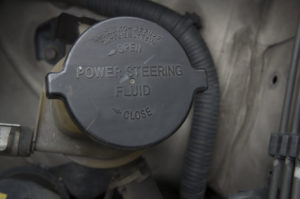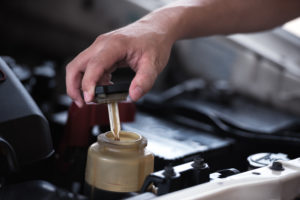Steering Clear of Issues
Power steering first appear in 1938 on large trucks. First patented by Francis Davis of Pierce Arrow (1932), power steering was only used on truck applications. In 1951, Chrysler made the first passenger car applications that used a hydraulically assisted power steering system using a pump operated by the engine. Throughout the years, there have been four pump types used for this application; roller, vane, slipper, and gear. The vane type pump is the most commonly encountered today. Regardless of the type, the function is the same; to provide hydraulic force for driver steering assistance. The biggest difference between pump systems today is how that pump is driven. With older hydraulic power steering systems, the pump, driven by the engine via belt, is constantly turning regardless of whether the driver requires steering assist or not. With the ongoing goal to improve efficiency, several OEM’s have gone to EPS (electric power steering) to improve fuel economy. The EPS systems typically use an electric motor attached to a gearbox on the steering rack, a sensor on the shaft running from the steering wheel tells the EPS motor when, and how much, to “assist” the driver. These systems provide power assist only when needed, reducing the amount of power scavenged from the engine, resulting in improved fuel efficiency.
 Power steering fluid is composed of mineral base oil (conventional base stocks are often used), or synthetic base oils, the choice for extreme cold applications and extended warranties. These fluids use an additive package to reduce or eliminate foaming, prevent wear, prevent oxidation and promote compatibility for the different types of seals, hoses and other chemically sensitive materials used in power steering systems. ATF is often used as power steering fluid because it is an excellent hydraulic fluid, in addition to many other properties (often not needed by power steering systems). As fluid needs have changed, so has the nature and type of lubricants specified for these systems. The OEM’s have chosen to go to power steering fluids designed for the specific application that are friendly to their system materials and provide long term performance for today’s extended warranties.
Power steering fluid is composed of mineral base oil (conventional base stocks are often used), or synthetic base oils, the choice for extreme cold applications and extended warranties. These fluids use an additive package to reduce or eliminate foaming, prevent wear, prevent oxidation and promote compatibility for the different types of seals, hoses and other chemically sensitive materials used in power steering systems. ATF is often used as power steering fluid because it is an excellent hydraulic fluid, in addition to many other properties (often not needed by power steering systems). As fluid needs have changed, so has the nature and type of lubricants specified for these systems. The OEM’s have chosen to go to power steering fluids designed for the specific application that are friendly to their system materials and provide long term performance for today’s extended warranties.
With the increased use of rack and pinion systems that share the power steering pump system and fluid, the problem of seal, hose and rubber component chemical deterioration became an issue. ATF’s can have a chemical makeup that over time causes certain materials to deteriorate, harden, wear, and eventually leak. Specific power steering fluids are the solution to this problem, and LUBEGARD® COMPLETE™ Synthetic PSF is one of them. The fluid is seal friendly and has comparable physical properties that make it function well as a hydraulic fluid for the pump as well as protect the other steering components.
Another issue with newer pumps and EPS pumps has to do with efficiency, and the reduction in fluid viscosity to provide adequate protection with a minimum “parasitic” loss due to viscosity. These new electric pump PSF’s are synthetic and are reduced viscosity for better performance in very cold weather. There is controversy over lubricants becoming thinner for improved efficiency. Conventional wisdom used to be “you need thicker fluids for better protection”, in many applications today, lower viscosity lubricants are performing as well or better than higher viscosity lubricants in all but the most extreme conditions where a thicker lube (Honda/Acura PSF) might provide some benefit.
Pump design can affect fluid type but not in the basic fluid requirements for system protection and material compatibility. What becomes more important, after the basic requirements for protection and compatibility are met, is the fluids ability to provide a uniform viscosity for the fluid’s life. Shear stability can be an issue, so it becomes important to make sure the fluid used for the system will meet the viscosity requirements initially as well as in the long haul. Power steering fluid systems are the most neglected system on vehicles, they need regular service with good fluids in order to last as long as the other systems on your vehicle.

Fluid flushing is a new concept for OEM’s. For years there were very few guide criteria other than looking at the power steering fluid and deciding it shouldn’t be black or dark brown. With warranty costs being as high as they are, many OEM’s now specify a mileage interval for preventative maintenance and provide the service at the dealership. The new systems that remove the fluid and replace power steering fluid from the fluid reservoir are reasonably effective at removing about 85% of the used fluid. If this fluid exchange is accompanied by the insertion of an inline filter (often magnetic, and called a transmission filter) on the low pressure return line, the removal of dirt, wear metals, tiny specks of rubber (hoses disintegrate over time on the inside yet look good on the outside) will greatly extend the life of the system and components. If this type of service is performed every 30,000 miles, the cost is reasonable, and power steering systems and components will stay in excellent condition.
With so many complaints about noisy pumps and erratic performance occurring because of depleted fluid or improper fluid levels, it becomes apparent, power steering systems have problems from neglect, and tired or improper power steering fluid. The best way to prevent problems is to pay attention to what kind of fluid or fluid additives (LUBEGARD PSF Protectant) you use (power steering additives of known quality and performance can enhance and protect the fluid and system components). Change fluid on a regular basis, use an inline filter, and make sure the fluid you use is compatible with the viscosity and material requirements of the OEM that built the vehicle. You do not have to go to the OEM dealership for the various “specified” power steering fluids used in vehicles today. You do have to use an equivalent product that will meet the system needs for viscosity, performance and material compatibility. With high-quality aftermarket lubricants available today, finding a fluid solution for your specific application shouldn’t be difficult and will allow you to meet or exceed the manufactures requirements.

